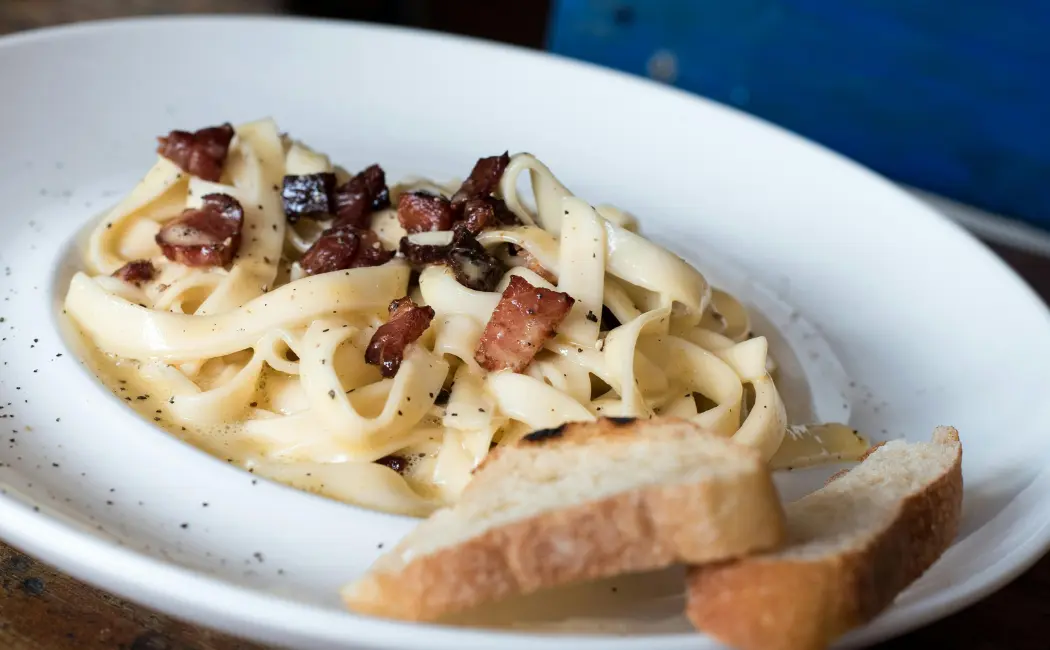Pasta Carbonara, Italy’s quintessential dish, has captivated the hearts and taste buds of food lovers worldwide.
This creamy, savory, and indulgent delight has become a staple of Italian cuisine, yet its origins and authentic preparation remain shrouded in mystery.
You May Also Like: Sushi: A Symbol of Japanese Tradition and Innovation
History of Carbonara
Carbonara’s roots date back to post-World War II Rome, where it emerged as a peasant dish. The name “Carbonara” derives from the Italian word for “coal miner” or “charcoal burner.”
One theory suggests that the dish was created by Italian coal miners, known as “carbonari,” who needed a hearty, filling meal.
Initially, Carbonara consisted of simple ingredients: bacon or pancetta, eggs, parmesan cheese, and black pepper.
The dish gained popularity in the 1950s and 1960s, spreading throughout Italy and eventually globally.
Authentic Ingredients and Preparation
A traditional Carbonara recipe requires:
- Guanciale or Pancetta: Italian cured pork jowl or bacon.
- Eggs: Fresh eggs, preferably from free-range chickens.
- Parmigiano-Reggiano: Aged Italian parmesan cheese.
- Black Pepper: Freshly ground.
To prepare an authentic Carbonara:
- Cook spaghetti al dente.
- In a separate pan, combine guanciale or pancetta, eggs, and parmesan cheese.
- Whisk eggs and cheese together.
- Add cooked spaghetti to the egg mixture.
- Season with black pepper.
Debunking Common Misconceptions
- No Cream: Traditional Carbonara does not contain cream.
- No Tomatoes: Carbonara is not a tomato-based sauce.
- No Garlic: Garlic is not a typical ingredient.
Regional Variations
While traditional Carbonara hails from Rome, regional variations exist:
- Carbonara alla Romana: Rome’s original recipe.
- Carbonara alla Toscana: Tuscan-style, featuring prosciutto instead of guanciale.
- Carbonara alla Veneta: Venetian-style, with added onions and white wine.
Modern Twists and Innovations
Contemporary chefs experiment with Carbonara:
- Vegetarian Carbonara: Replacing guanciale with roasted vegetables.
- Seafood Carbonara: Adding shrimp or scallops.
- Egg-Free Carbonara: Substituting eggs with cream or yogurt.
Celebrity Chefs’ Takes
Renowned chefs share their Carbonara interpretations:
- Jamie Oliver: Adds cherry tomatoes and basil.
- Gordon Ramsay: Uses prosciutto instead of guanciale.
- Mario Batali: Emphasizes guanciale’s importance.
Conclusion
Carbonara’s rich history and authentic flavors have captivated food enthusiasts worldwide.
By understanding the origins and traditional preparation, we can appreciate the simplicity and elegance of this beloved Italian dish.
References
- “The Oxford Companion to Italian Food” by Gillian Riley.
- “Carbonara: A Recipe’s Evolution” by The New York Times.
- “The Essentials of Italian Cooking” by Marcella Hazan.
Fact Box
- Originated in post-World War II Rome.
- Name “Carbonara” derives from Italian coal miners.
- Traditional ingredients: guanciale, eggs, parmesan cheese, and black pepper.
- No cream or tomatoes in authentic recipe.
- Regional variations exist throughout Italy.










